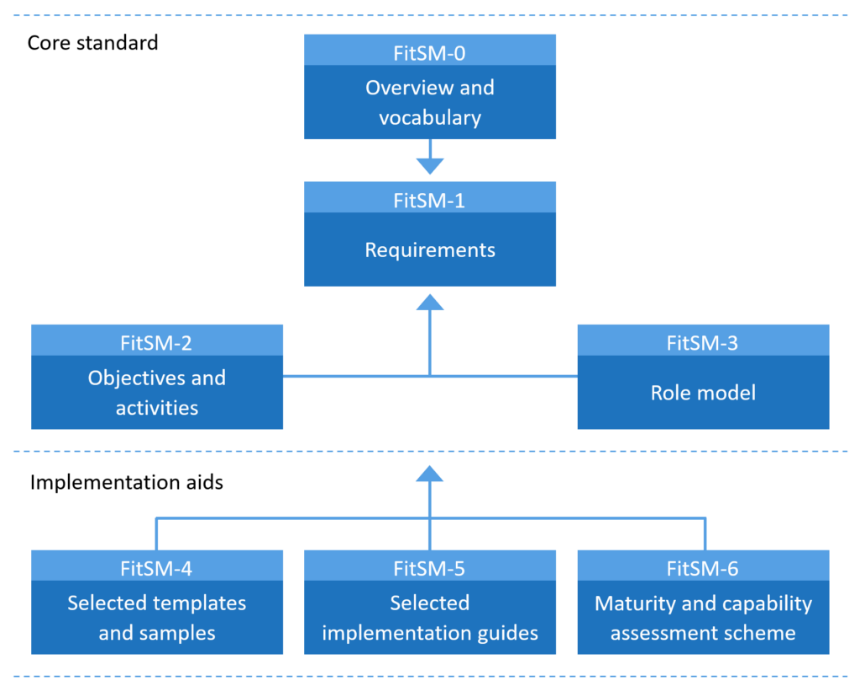FitSM – the Free, Lightweight
ITSM Standard
05 mins read
There are many IT service management (ITSM) best practice frameworks, methodologies, and standards available to organizations looking to improve their IT service delivery and support capabilities (and the business outcomes that result). However, one that you might not have heard of, especially given ITIL's giant shadow, is FitSM. It differs from most other ITSM frameworks, methodologies, and standards in its focus and because the standard and associated training materials are available for free. This blog explains what FitSM is and what it offers to organizations.
A FitSM 101
FitSM is marketed as the "lightweight" standard for ITSM. It's designed to help organizations of all sizes deliver, support, and manage their IT services. It differs from ITIL by being a standard, not a framework, and from ISO/IEC 20000 – the International Standards Organization (ISO) service management standard – by being far less stringent. A second FitSM blog will explain the differences between FitSM and the other popular ITSM frameworks, methodologies, and standards.
The primary goals of the FitSM standard
The FitSM website states that the lightweight ITSM standard aims to:
- "Create a clear, pragmatic, lightweight and achievable standard that allows for effective ITSM.
- Offer a version of ITSM which is more accessible for a wider range of environments than traditional ITSM solutions, including federated scenarios.
- Provide solutions which can be efficiently implemented in organizations ranging from SMEs and start-ups through to large enterprises.
- Define a baseline of ITSM effectiveness that is achievable but can be expanded if necessary."
An overview of the FitSM standard
The FitSM standard comprises seven elements, as shown in the diagram below.

Each of these elements is described below:
- FitSM-0: Overview and vocabulary. An overview of the FitSM elements and a common vocabulary that aids discussions on ITSM implementation using FitSM or other ITSM approaches.
- FitSM-1: Requirements. A set of requirements for ITSM specifically designed for organizations with federated infrastructures or that are new to ITSM. It offers a lightweight and achievable approach for effectively managing IT services and covers 14 core ITSM processes:
- Capacity management
- Change management
- Configuration management
- Continual service improvement management
- Customer relationship management
- Incident and service request management
- Information security management
- Problem management
- Release and deployment management
- Service availability and continuity management
- Service level management
- Service portfolio management
- Service reporting management
- Supplier relationship management.
- FitSM-2: Objectives and activities. A set of goals and recommended activities to assist in fulfilling the FitSM-1 requirements. First, the generic service management system goals and activities, then process-specific objectives and activities. These aren't exhaustive but offer initial guidance for meeting the FitSM-1 requirements.
- FitSM-3: Role model. A model of roles and responsibilities required in ITSM implementation. These let FitSM implementers assign the initial roles within their organization.
- FitSM-4: Selected templates and samples. Ready-to-use templates and samples for the documentation required in ITSM implementation. The downloadable files are organized by FitSM-1 sections and processes.
- FitSM-5: Selected implementation guides. Implementation guidance, such as guides on applying specific templates. Again, the downloadable files are organized by FitSM-1 sections and processes.
- FitSM-6: Maturity and capability assessment scheme. A capability/maturity assessment model that allows organizations to check and demonstrate their current FitSM capabilities and overall ITSM maturity. IT service providers can understand where to improve their capabilities and demonstrate their progress. The assessment is based on how the requirements (from FitSM-1) are met at different levels of capability.
FitSM training and certification
The FitSM certification program for individuals offers three levels: Foundation, Advanced, and Expert.
The FitSM Foundation certificate is a one-day course and a 30-minute multiple-choice exam. It recognizes an understanding of the basics of ITSM and the FitSM standard. There are two Advanced certificates, each taking two days to complete – the FitSM Advanced Service Operation and Control (SOC) exam and the FitSM Advanced Service Planning and Delivery (SPD) exam.
Upon achieving both Advanced certifications, the FitSM Expert certification can be taken. This certification is designed for ITSM consultants and auditors. ITIL Expert certification holders qualify for an Expert Bridge course, allowing them to quickly progress to FitSM Expert status.
Unlike ITIL, where only individuals become certified, there's now a FitSM organizational certification. The FitSM Working Group has developed a scheme with APMG International for an organization-level certification that demonstrates FitSM implementation in line with FitSM-1 requirements. It requires a certified FitSM auditor to spend a few days (depending on the organization's size) formally reviewing the organization's service management implementation.
Why choose FitSM?
FitSM has two key benefits over other ITSM frameworks, methodologies, and standards. Its:
- Relative simplicity
- Cost.
First, FitSM offers a concise and pragmatic approach to ITSM, making it particularly helpful for smaller organizations or those beginning their ITSM journey. Importantly, it focuses on the most essential ITSM processes required to manage IT services effectively. In terms of use cases, it can be considered an "exploratory" option – allowing an organization to assess the suitability of ITSM best practice use before investing in the certification or a more involved ITSM framework, methodology, or standard. If the latter happens, FitSM is designed to be compatible with other ITSM frameworks, methodologies, and standards, and organizations can thus use it as a stepping stone to more comprehensive approaches. It can also be used when the speed of ITSM adoption is important. For example, an external audit might recommend adopting ITSM practices, and FitSM is a great option to facilitate the adoption of ITSM "basics."
Second, FitSM is ideal for organizations with budgetary limitations because all training materials are free to access and use. The cost and simplicity make it particularly attractive to smaller organizations, educational and research institutions, and organizations that require a cost-effective solution for managing IT services. This benefit aligns well with the two use cases above. Because the minimal initial financial investment means that "exploratory" costs aren't wasted, and the rapid adoption of ITSM capabilities isn't delayed by the need for a business case or any other barriers to funding the required improvement.
How free is "free"? Or what does FitSM cost?
The FitSM website states it "is and will remain free for everybody."
This free-for-ever promise covers all six elements of the standard and the associated training materials for each FitSM training and certification scheme module. The FitSM standard and the related materials are all licensed under a Creative Commons International License. However, while training materials are free, the certifications themselves are not.

